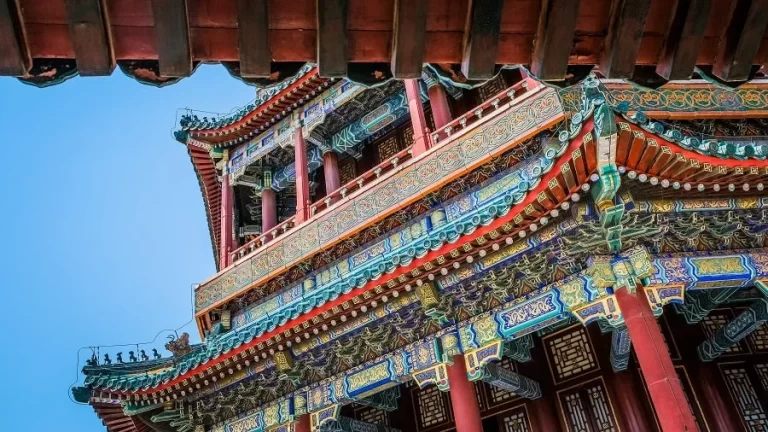Buddhist temples and monasteries are one of China’s cultural treasures. Even though most of these were built more than a thousand years ago, they remain still in use today by Buddhist monks. If you’re interested in sightseeing and learning about Chinese culture, a visit to a Buddhist temple or monastery is highly recommended, whether you’re a tourist or a local who wants to see what makes Chinese Buddhism so unique. Here are 10 must-visit Buddhist temples in China that will make your trip even better!
Table of Contents
ToggleTop 10 China Buddhist Temple to See
1. The Shaolin Temple, Songshan Mountain
Held to be the seat of Zen Buddhism in China, the magnificent Shaolin Temple is one of the oldest Buddhist sites to be found in China. This temple was first founded during the Northern Wei Dynasty. With a history spanning more than 1500 years, the Shaolin Temple deserves to be called a genuinely world-famous Buddhist temple. It plays host to several well-known buildings and sites, like the Arhat Hall and the Forest of Steles, containing the ashes of famous Buddhist monks spread across 248 brick pagodas.

2. South Putuo Temple, Xiamen
One of the only temples that can match the Shaolin Temple’s worldwide fame is the South Putuo Temple, a Buddhist site in the Xiamen city of China. The temple faces a grand lake and is surrounded by lush greenery, creating the perfect serene environment. The temple also holds the Thousand-Hand Buddha, one of the few surviving such statues.

3. Jokhang Temple, Lhasa
Playing host to the Great Prayer Festival every year between January and March is the Jokhang Temple, a great site dedicated to Tibetan Buddhism. When you first stand outside its still well-maintained walls, you’ll see pilgrims, actual monks, scattered all over the place. The temple itself has a rich history as the chosen place of worship of Tang Princess Wen Cheng, a Tibetan Queen.

4. Famen Temple, Fufeng County
Built during the waning days of the renowned Eastern Han Dynasty, the Famen Temple has been destroyed, ruined, and rebuilt time and again. Proving to be as resilient as the followers of the religion it’s dedicated to, this stunning temple is said to hold thousands of Buddhist relics, including the Fingernail of Sakyamuni (Gautama Buddha). While it has been a refuge to Buddhist pilgrims for over 1700 years, plan your trip carefully as Sakyamuni’s Finger Sarira (relic) is only displayed on certain lunar days.

5. Tashilhunpo Monastery, Shigatse City
The first monastery on this list is the Tashilhunpo Monastery, a grand complex that houses the revered Panchen Lama, a Buddhist leader placed directly after the Dalai Lama. It covers more than 150,000 square meters and is considered one of the Four Major Monasteries of Tibetan Buddhism. Some highlights are the Chapel of Jamba (the Future Buddha) and the stupas of previous Panchen Lama leaders.

6. Sertar Larung Gar, Sertar County
When seen from above, SertarLarung Gar looks like a sea of red poppies stretching as far as the eye can see. It’s only when seen from close, however, that one realizes it’s a sea of buildings housing the most prominent Buddhist academy in the world. With more than 20,000 Buddhist apprentices studying in the hundreds of buildings in SertarLarung Gar, this stunning site turns into a sea of lights at night.
However, as large parts of it are under reconstruction, most of it remains roped off to tourists.

7. White Horse Temple, Luolong District
The oldest Buddhist temple in China is almost more than 2000 years old, and it’s none other than the White Horse Temple in the Luolong District. Built in 64 AD, when the Han Dynasty ruled mainland China, White Horse Temple was the first Buddhist temple erected in China.
The temple features luxurious lacquered wood furnishings, great statues of Buddha everywhere, and many halls dedicated to translating Buddhist scripture.

8. Wannian Temple, Mount Emei
Don’t let its golden looks fool you. The Wannian Temple is every bit as ancient and essential to Buddhist history as it is luxurious, as this temple plays host to Buddhist relics like the Tooth of Buddha. While there, try and get a glimpse of the sacred frog that resides in the rectangular pond near the temple and get the soothing peace the legends say its melodious sounds bring upon people.

9. The Hanging Temple, Hunyan County
The Hanging Temple is one that needs no introduction. Built into the side of a sheer cliff 50 meters above ground, this temple features Taoist, Buddhist, and Confucian themes and motifs across three different buildings: the Southern Pavilion, the Changxian Bridge, and the Northern Pavilion. While the beautiful carvings all over certainly aren’t to be missed, the highlights are the giant statues of the three founders of the religions: Laozi (Taoism), Shakyamuni (Buddhism), and Confucius (Confucianism).

10. Wenshu Monastery, Qingyang District
One of the four main monasteries dedicated to Zen Buddhism in China is the Wenshu Monastery, a beautiful set of structures that grew out of a single courtyard. It counts among its features several palaces constructed in Qing Dynasty style, with thousands of Buddhist statues and paintings decorating its walls. Don’t forget to visit the old-school Teahouse, which provides Chinese tea and hosts folk shows.

The Takeaway
While China does have a history of its own, today, it’s undeniable that Buddhism plays as large a role in it as it does in the history of India and Nepal. The rulers of China felt the same calling to this peaceful religion as thousands of other devotees worldwide. If you want proof, take a taxi to one of the hundreds of monasteries, stupas, and temples dotting the rolling landscapes of this fascinating country.
